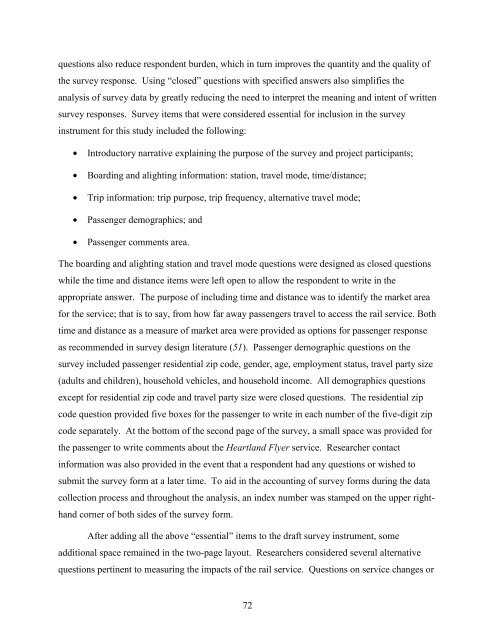Measuring the Benefits of Intercity Passenger Rail: A Study
Measuring the Benefits of Intercity Passenger Rail: A Study
Measuring the Benefits of Intercity Passenger Rail: A Study
Create successful ePaper yourself
Turn your PDF publications into a flip-book with our unique Google optimized e-Paper software.
questions also reduce respondent burden, which in turn improves <strong>the</strong> quantity and <strong>the</strong> quality <strong>of</strong><br />
<strong>the</strong> survey response. Using “closed” questions with specified answers also simplifies <strong>the</strong><br />
analysis <strong>of</strong> survey data by greatly reducing <strong>the</strong> need to interpret <strong>the</strong> meaning and intent <strong>of</strong> written<br />
survey responses. Survey items that were considered essential for inclusion in <strong>the</strong> survey<br />
instrument for this study included <strong>the</strong> following:<br />
• Introductory narrative explaining <strong>the</strong> purpose <strong>of</strong> <strong>the</strong> survey and project participants;<br />
• Boarding and alighting information: station, travel mode, time/distance;<br />
• Trip information: trip purpose, trip frequency, alternative travel mode;<br />
• <strong>Passenger</strong> demographics; and<br />
• <strong>Passenger</strong> comments area.<br />
The boarding and alighting station and travel mode questions were designed as closed questions<br />
while <strong>the</strong> time and distance items were left open to allow <strong>the</strong> respondent to write in <strong>the</strong><br />
appropriate answer. The purpose <strong>of</strong> including time and distance was to identify <strong>the</strong> market area<br />
for <strong>the</strong> service; that is to say, from how far away passengers travel to access <strong>the</strong> rail service. Both<br />
time and distance as a measure <strong>of</strong> market area were provided as options for passenger response<br />
as recommended in survey design literature (51). <strong>Passenger</strong> demographic questions on <strong>the</strong><br />
survey included passenger residential zip code, gender, age, employment status, travel party size<br />
(adults and children), household vehicles, and household income. All demographics questions<br />
except for residential zip code and travel party size were closed questions. The residential zip<br />
code question provided five boxes for <strong>the</strong> passenger to write in each number <strong>of</strong> <strong>the</strong> five-digit zip<br />
code separately. At <strong>the</strong> bottom <strong>of</strong> <strong>the</strong> second page <strong>of</strong> <strong>the</strong> survey, a small space was provided for<br />
<strong>the</strong> passenger to write comments about <strong>the</strong> Heartland Flyer service. Researcher contact<br />
information was also provided in <strong>the</strong> event that a respondent had any questions or wished to<br />
submit <strong>the</strong> survey form at a later time. To aid in <strong>the</strong> accounting <strong>of</strong> survey forms during <strong>the</strong> data<br />
collection process and throughout <strong>the</strong> analysis, an index number was stamped on <strong>the</strong> upper righthand<br />
corner <strong>of</strong> both sides <strong>of</strong> <strong>the</strong> survey form.<br />
After adding all <strong>the</strong> above “essential” items to <strong>the</strong> draft survey instrument, some<br />
additional space remained in <strong>the</strong> two-page layout. Researchers considered several alternative<br />
questions pertinent to measuring <strong>the</strong> impacts <strong>of</strong> <strong>the</strong> rail service. Questions on service changes or<br />
72
















